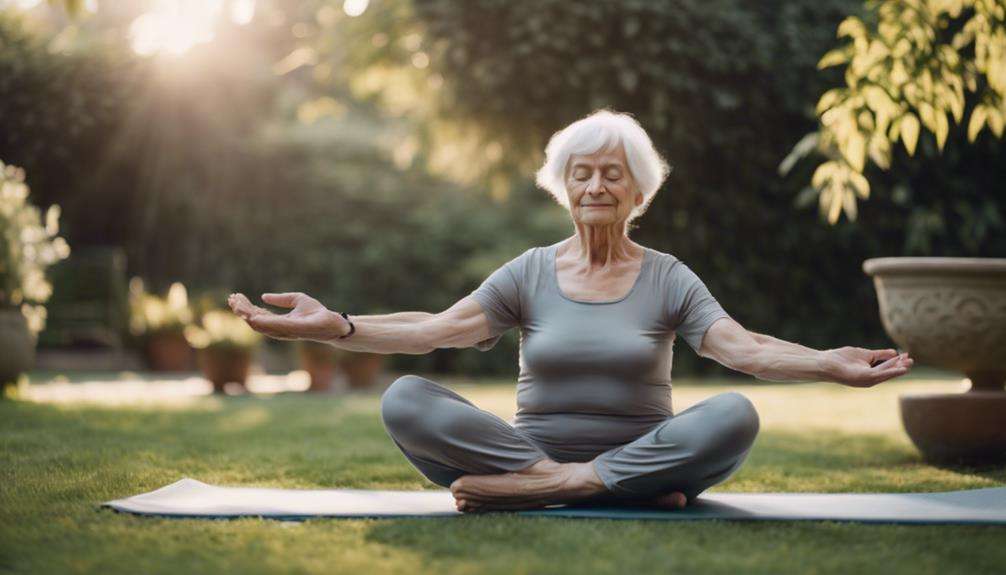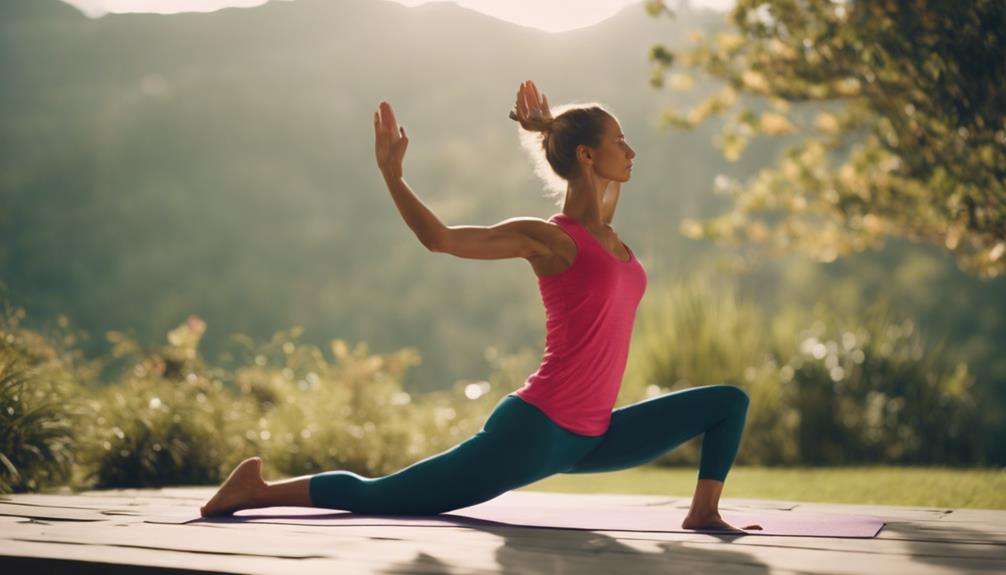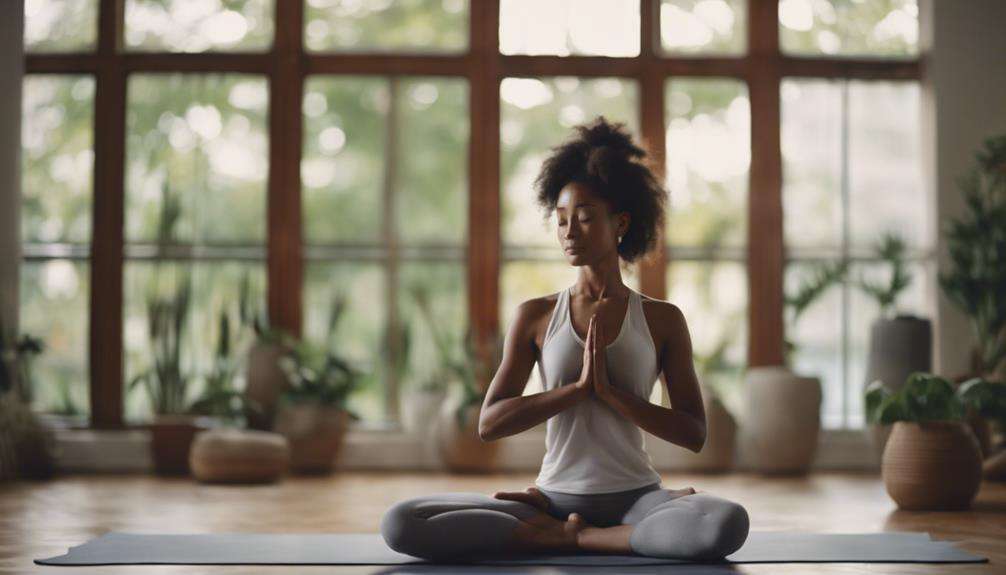So, you've been about as flexible as a board lately, huh? Well, what if you could unlock a range of motion you never knew you had?
Imagine breezing through your day without feeling like you're carrying the weight of the world on your shoulders. What's the secret? It might be simpler than you think…
Key Takeaways
- Incorporate daily stretching to maintain and improve flexibility.
- Utilize breath work, like diaphragmatic breathing, to enhance flexibility.
- Combine yoga practices to target major muscle groups and mental well-being.
- Consistently engage in post-exercise routines for long-term flexibility maintenance.
Foam Rolling for Flexibility
If you're looking to improve your flexibility and reduce muscle tightness, foam rolling is a highly effective technique worth incorporating into your routine. Foam rolling targets muscle tightness, promoting blood flow, and enhancing flexibility.
By using self-myofascial tools such as massage sticks and balls, you can release tension in muscles and fascia, further aiding flexibility. Various muscle groups like hamstrings, quadriceps, and back muscles can benefit significantly from foam rolling, leading to improved range of motion and reduced muscle soreness.
Incorporating foam rolling into your regular routine can help maintain and enhance flexibility over time. The practice of foam rolling not only aids in short-term flexibility improvement but also contributes to long-term benefits by keeping your muscles supple and healthy.
Remember to focus on proper technique and consistency when foam rolling to optimize its effects on your flexibility and overall muscle health.
Dynamic Stretching Techniques
To further enhance your flexibility and muscle health, let's explore dynamic stretching techniques that actively engage your muscles and improve your range of motion. Dynamic stretching involves active movements that mimic the activity you're about to perform, making it an excellent choice for a warm-up routine.
Here are some key benefits and tips for incorporating dynamic stretching into your workout:
- Improves Muscle Elasticity: Dynamic stretching helps enhance muscle elasticity, making your muscles more pliable and less prone to injuries.
- Enhances Range of Motion: By actively moving through a full range of motion, dynamic stretching can help increase your flexibility and joint mobility.
- Effective Warm-Up: Using dynamic stretches as part of your warm-up routine can prepare your body for the dynamic movements you'll perform during your workout.
- Enhanced Performance: Incorporating dynamic stretching into your pre-activity routine can boost your performance and reduce the risk of injury during physical exertion.
Static Stretching Post-Activity
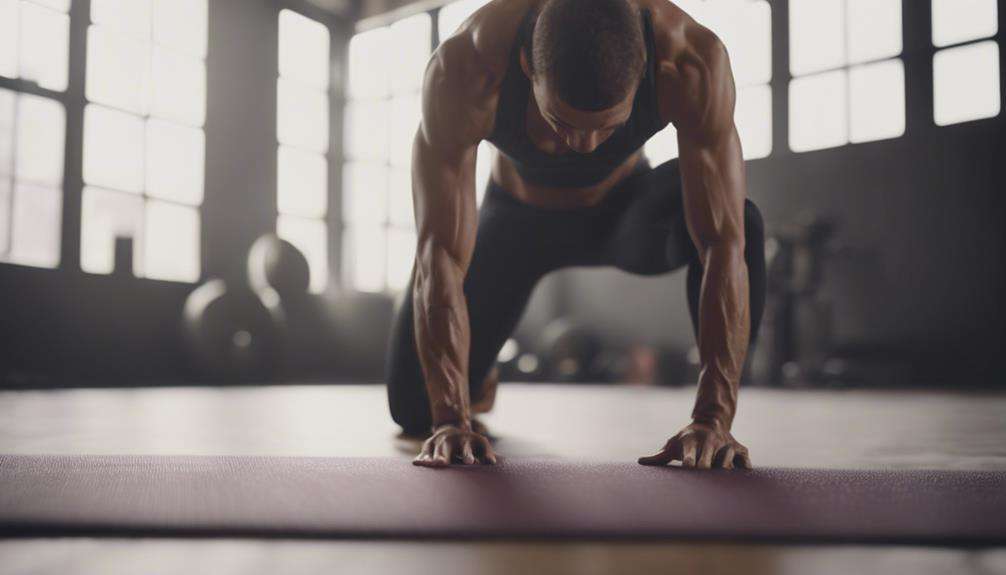
After your workout, taking a few minutes for static stretching can make a significant difference in your flexibility. Holding each stretch for about 20 seconds can help your muscles relax and lengthen, reducing the risk of tightness.
Incorporating this practice post-activity may lead to improved muscle balance and overall flexibility.
Stretching Benefits
Engage in static stretching post-activity to enhance flexibility and prevent muscle stiffness and soreness.
Static stretching helps maintain and improve flexibility by elongating muscles, reducing tension, and improving range of motion. Remember to hold each stretch for at least 20 seconds, repeating 2-4 times for optimal gains.
By incorporating static stretching into your routine, you can improve joint flexibility and overall muscle health. This practice on warm muscles post-activity is key to preventing stiffness and soreness, contributing to long-term flexibility maintenance.
Make static stretching a consistent part of your post-exercise routine for better flexibility outcomes and enhanced muscle health.
Timing and Frequency
Begin your post-activity static stretching routine when your muscles are warm to optimize flexibility enhancement and prevent stiffness. Holding each static stretch for at least 20 seconds, repeated 2-4 times, can significantly improve flexibility.
Consistency is key – incorporating static stretching daily post-activity helps maintain and increase flexibility over time. Remember not to push your muscles to their maximum limits during static stretching; focus on proper technique for effectiveness.
Targeted Stretching for Problem Areas
To enhance your flexibility and address specific problem areas, targeted stretching offers a tailored approach focusing on tight muscles or restricted joints. By incorporating targeted stretching into your routine, you can effectively stretch and strengthen specific areas that need attention.
Here are some key points to consider:
- Focus on Specific Areas: Targeted stretching allows you to concentrate on particular muscle groups or joints that may be tight or restricted, helping to improve flexibility in those specific areas.
- Customized Approach: Tailoring your stretching routine to your individual needs and goals ensures that you address the areas that require the most attention, promoting overall flexibility and joint health.
- Enhanced Range of Motion: By pinpointing and stretching tight muscles, you can increase your range of motion and reduce discomfort associated with stiffness.
- Muscle Imbalance Correction: Targeted stretching helps correct muscle imbalances and asymmetries, promoting better overall body alignment and function.
Incorporating targeted stretching into your routine can lead to significant improvements in flexibility and overall well-being.
Consistent Stretching Routine
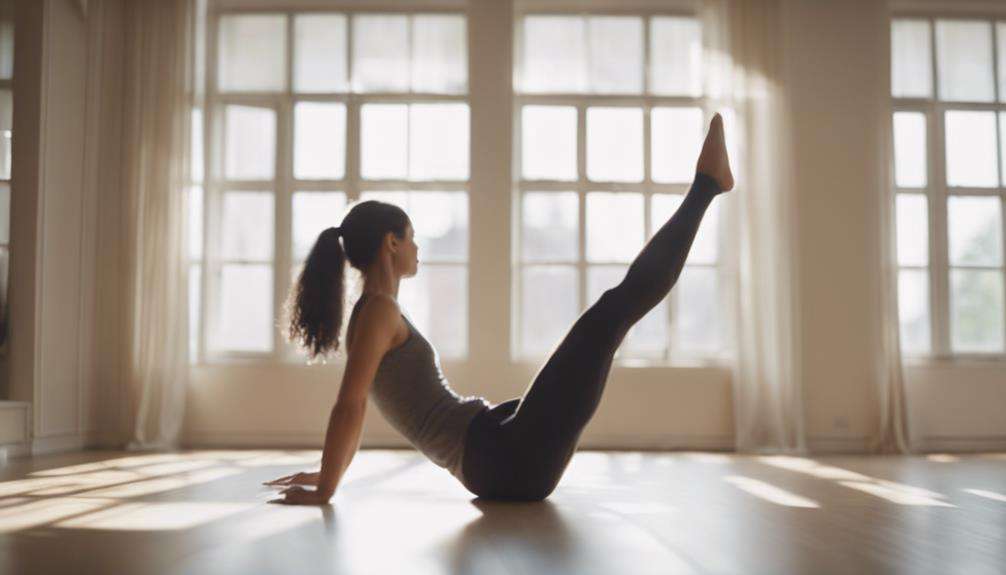
To boost your flexibility effectively, it's crucial to maintain a consistent stretching routine. By committing to daily stretching sessions, you can prevent muscle stiffness and enhance your range of motion over time.
Stretching Frequency
For optimal results in your journey towards increased flexibility, establishing a consistent stretching routine is essential.
Here are some key points to consider regarding stretching frequency:
- Daily Stretches: Stretch tight areas daily to maintain and improve flexibility.
- Multiple Stretches: Performing multiple stretches per day can prevent flexibility loss.
- Maintain Gains: Regular stretching helps in maintaining flexibility gains.
- Consistency Matters: Skipping stretches or lacking consistency can hinder flexibility progress.
Stretch Duration
Ensure your consistent stretching routine includes holding stretches for a minimum of 20 seconds to enhance flexibility gains effectively. By repeating each stretch 2-4 times per session, you can further boost your flexibility progress.
Remember, consistency is key in maintaining and improving flexibility. Avoid pushing yourself to the limit during stretches to prevent injuries; instead, focus on gradual progress.
Regularly stretching tight areas daily can significantly contribute to your flexibility journey. By incorporating these practices into your routine, you increase the likelihood of transitioning from stiffness to flexibility successfully.
Stay committed to your stretch duration and routine for optimal results in achieving increased flexibility and mobility.
Safe Muscle Stretching Practices
When stretching your muscles for flexibility, ensure you hold static stretches for at least 20 seconds to improve your range of motion and prevent potential injuries. It's essential to take care of your health and well-being by following safe muscle stretching practices.
Here are some tips to help you stretch effectively and avoid injuries:
- Avoid bouncing: Maintain smooth movements to reduce the risk of muscle strain.
- Focus on major muscle groups: Target areas like hamstrings and shoulders for effective flexibility training.
- Incorporate dynamic stretching: Prepare your muscles by including dynamic stretches before activities to increase flexibility.
- Listen to your body: Pay attention to your body's feedback during stretching to prevent pushing beyond safe limits and causing harm.
Importance of Diaphragmatic Breathing
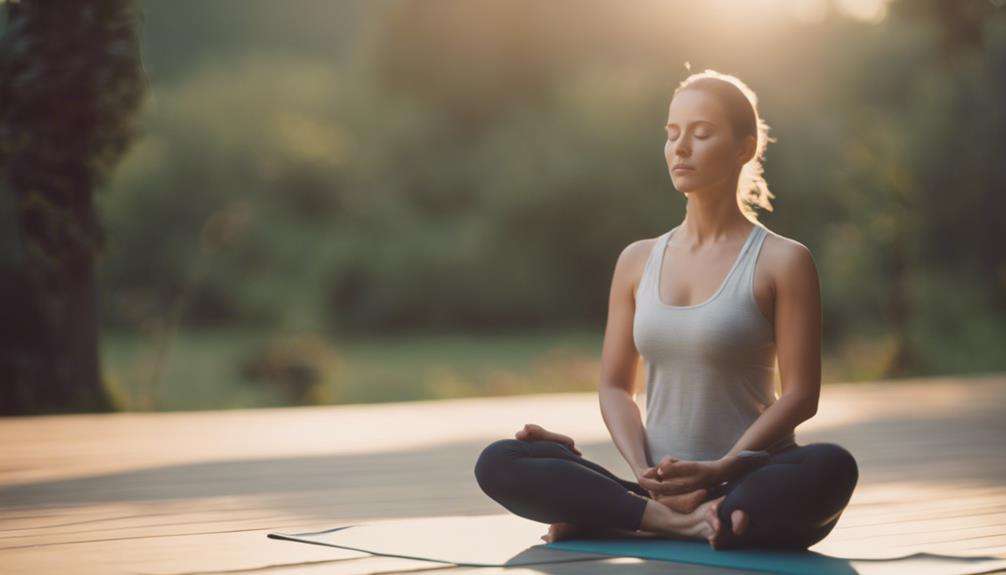
To optimize your flexibility and enhance your stretching exercises, understanding the significance of diaphragmatic breathing is crucial. Diaphragmatic breathing, also known as deep belly breathing, involves engaging your diaphragm and core muscles to take deep breaths. This technique not only improves the efficiency of oxygen exchange in your body but also plays a vital role in enhancing flexibility. By practicing diaphragmatic breathing during stretching routines, you can increase body awareness and better connect with your muscles, allowing for a deeper and more effective stretch.
Incorporating breath work into your flexibility training can make a significant difference. Proper breathing technique helps in relaxing your muscles, making it easier to stretch further without feeling as much tension or discomfort. Moreover, deep, controlled breaths can assist in strengthening your core muscles, providing better support for your spine and improving overall stability during stretches. By focusing on your breath and incorporating diaphragmatic breathing into your routine, you can maximize the benefits of your flexibility training sessions.
Incorporating Yoga for Flexibility
If you're looking to enhance your flexibility, incorporating yoga into your routine can be incredibly beneficial.
Yoga poses like child pose, upward dog, and downward dog are known to significantly improve flexibility.
Yoga Poses Benefits
Incorporating yoga into your routine can lead to significant improvements in flexibility by stretching major muscle groups and promoting muscle relaxation. Basic yoga poses like child pose, upward dog, and downward dog enhance flexibility by targeting key muscle groups.
Regular practice of simple yoga can help increase flexibility, reduce stiffness, and aid in muscle relaxation. Yoga's accessibility across various fitness levels makes it a versatile option for enhancing flexibility and overall physical well-being.
This ancient practice not only alleviates muscle soreness but also contributes to improved mental well-being through its stretching benefits. Embrace yoga as a tool to prevent muscle stiffness and enhance your overall flexibility for better movement and a healthier lifestyle.
Flexibility Improvement Tips
Enhance your flexibility and mobility by incorporating specific yoga poses that target key muscle groups and promote relaxation, leading to improved overall physical well-being.
Regular practice of yoga can significantly improve flexibility levels, as basic poses engage multiple muscle groups simultaneously.
Yoga poses like child pose, upward dog, and downward dog are effective for enhancing flexibility. These dynamic stretches help reduce the risk of muscle soreness and stiffness, promoting relaxation and overall health.
By focusing on areas like the hip flexors, yoga can aid in increasing flexibility and reducing the likelihood of injury.
Remember that consistency is key when incorporating yoga into your routine to see long-term improvements in your flexibility and mobility.
Meditation for Flexibility Benefits

To boost your flexibility and overall well-being, consider integrating meditation into your routine. Meditation offers various benefits that can significantly improve your flexibility:
- Mindfulness practices: Engaging in mindfulness during meditation can enhance your body awareness. This increased awareness allows you to focus better on your stretching and movement activities, promoting flexibility.
- Deep breathing techniques: Incorporating deep breathing techniques in your meditation sessions can improve the oxygen flow to your muscles. This increased oxygenation aids in the development of flexibility by supporting muscle function and relaxation.
- Consistent practice: Establishing a regular meditation practice can lead to mental clarity and reduced muscle tension. This reduction in tension can contribute to improved flexibility over time as your body becomes more relaxed and responsive to stretching exercises.
- Relaxation and stress reduction: Meditation promotes relaxation, helping to release tight muscles and reduce overall stress and tension in the body. This relaxation can support your flexibility goals by creating a more conducive environment for stretching and movement.
Maintaining Flexibility for Wellness
Boost your overall wellness by maintaining flexibility through regular stretching routines. Flexibility plays a crucial role in keeping your muscles and joints healthy. By incorporating stretching exercises into your daily routine, you can improve your range of motion and prevent stiffness that may hinder your daily activities.
Consistent flexibility training not only enhances joint health but also helps in releasing muscle tension, promoting relaxation, and improving your aerobic fitness levels. Moreover, combining breath work and strength training with your stretching routines can further boost your flexibility and mobility.
Remember that flexibility isn't only about touching your toes but also about ensuring that your body can move freely and efficiently. So, make sure to dedicate time to stretch regularly, listen to your body, and reap the numerous benefits that flexibility can offer for your overall wellness.
Frequently Asked Questions
How Do You Go From Stiff to Flexible?
To improve flexibility from stiffness, focus on incorporating stretching techniques like dynamic and static stretches. Gradually progress in flexibility training with mobility exercises and specific yoga poses. Consistency in your routine is key for long-term flexibility gains.
Can a Very Stiff Person Become Flexible?
You, as a very stiff person, can become flexible through tailored stretching techniques, targeted yoga poses, gradual flexibility progress, dynamic mobility exercises, and setting specific flexibility goals. Seek guidance from professionals for personalized strategies.
Why Am I so Stiff and Not Flexible?
Feeling stiff and inflexible can be due to prolonged sitting, lack of movement, poor posture, or aging. Incorporating stretching routines, mobility exercises, yoga, foam rolling, and flexibility training into your routine can help improve flexibility and reduce stiffness.
Is It Possible to Regain Flexibility?
You can definitely regain flexibility by incorporating stretching techniques, yoga practice, mobility exercises, massage therapy, and flexibility training into your routine. Consistency and patience are key in gradually improving your flexibility.
Conclusion
As you continue on your journey from stiffness to flexibility, remember that consistency is key. Just like a flower needs daily sunlight to bloom, your body needs regular stretching to thrive.
Embrace the process with patience and dedication, and you'll soon find yourself moving with grace and ease, like a gentle breeze through a field of wildflowers.
Keep stretching, keep moving, and watch your flexibility soar.




